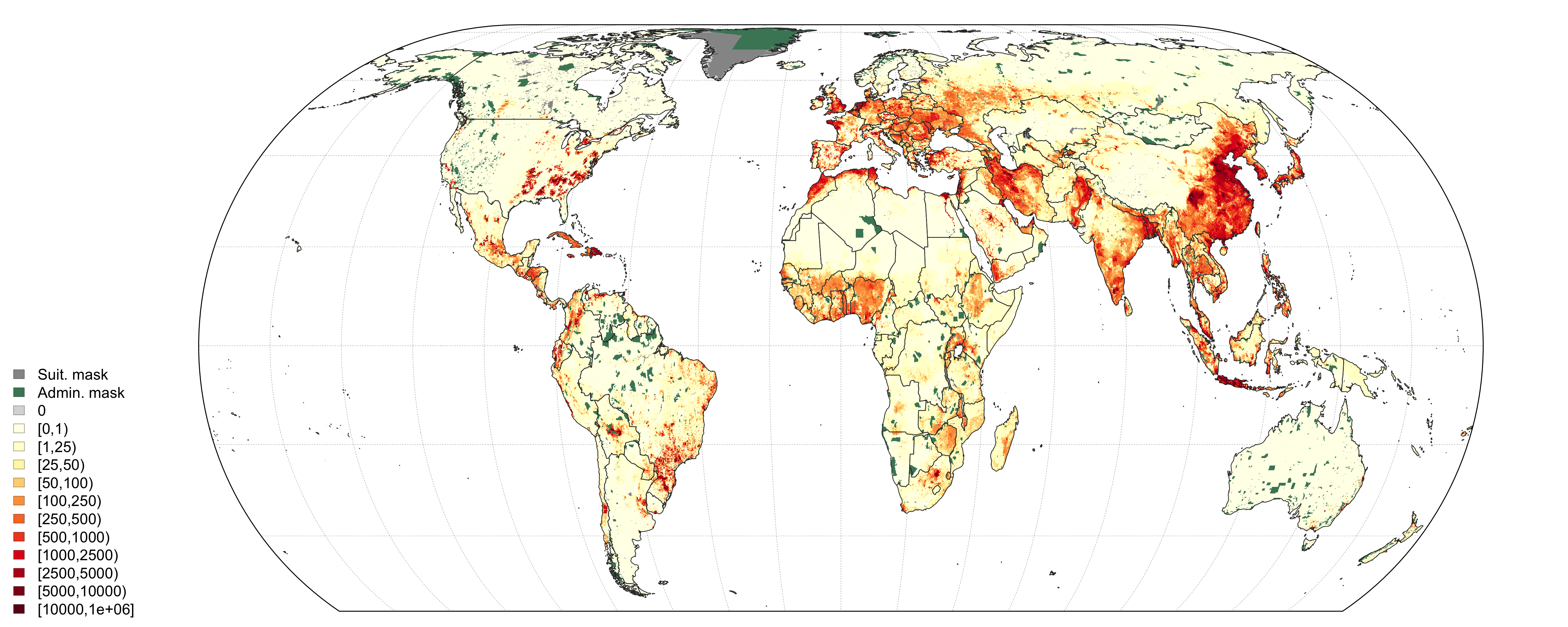Mapping livestock
Background
For many years, several research groups and international organisations have developed high-resolution global maps of livestock based on reported statistics derived from census and survey data. Due to the dynamic nature of these populations (intensification of livestock production) this is an extremely challenging task that involves the collection of contemporary statistics, the development of complex algorithms to disaggregate these statistics at higher spatial resolutions and make predictions where they are absent.

Global output distribution of chicken density of the Gridded Livestock of the World (GLW3) (Gilbert et al. 2018)
Ongoing work
The main objectives of our ongoing work are to evaluate quantitatively and qualitatively the different approaches that are used to predict and represent livestock distribution in high-resolution global databases. Our initial efforts focused on the establishment of global livestock distribution data representing the best data available to date (Gilbert et al. 2018).
We now work on the development of time series for the past (1990 - present) and for the future (present - 2050) based on time series of predictor variables and on adapted modelling procedures that can take advantages of training data in space and time.
In parrallel, we also worked on the development of different models that are better suited to predict monogastric species (poultry and pigs) that can be raised in very high number within a single locations. We investigated the use of point-pattern simulation modelling to predict farm locations (Chaiban et al. 2019) and ocne calibrated, the approach will be applied to create realistic synthetic farm distribution models in relevant countries.
Perspectives
Further developments involve predicting how intensification of the livestock production sector may impact the geoghraphical distribution of animals and farms in ruminant and monogastric livestock production systems. We also work toward the development of animal movement models (Nicolas et al. 2018) that can be used to predict movement networks.
Dissemination
Our work is carried out in collaboration with the FAO Livestock and Environment group, and is presented in FAO Livestock Systems web page. The data themselves are distributed through the Global Livestock Data Harvard dataverse.
Collaborations
Our main institutional collaborators are T. Robinson & G. Cinardi (Livestock and Environment, FAO, Rome, Italy), W. Thanapongtharm (Department of Livestock Development, DLD, Bangkok, Thailand), H. Yu (Chinese Center for Disease Control, CDC, Beijing, China), and our main academic collaborators are W. Wint (ERGO, Oxford, UK) & S. Vanwambeke (UCL, Louvain-la-Neuve, Belgium).
Related publications
Point pattern simulation modelling of extensive and intensive chicken farming in Thailand: Accounting for clustering and landscape characteristics
C. Chaiban, C. Biscio, W. Thanapongtharm, M. Tildesley, X. Xiao, T. P. Robinson, S. O. Vanwambeke, and M. Gilbert.
"Agricultural Systems",
Vol. 173,
Pages 335-344,
2019.
Predictive gravity models of livestock mobility in Mauritania: The effects of supply, demand and cultural factors
G. Nicolas, A. Apolloni, C. Coste, G. R. W. Wint, R. Lancelot, and M. Gilbert.
"PLOS ONE",
Vol. 13,
Issue 7,
Pages e0199547,
2018.
Global distribution data for cattle, buffaloes, horses, sheep, goats, pigs, chickens and ducks in 2010
M. Gilbert, G. Nicolas, G. Cinardi, T. P. Van Boeckel, S. O. Vanwambeke, G. R. W. Wint, and T. P. Robinson.
"Scientific Data",
Vol. 5,
Pages 180227,
2018.
Using Random Forest to Improve the Downscaling of Global Livestock Census Data
G. Nicolas, T. P. Robinson, G. R. W. Wint, G. Conchedda, G. Cinardi, and M. Gilbert.
"PLOS ONE",
Vol. 11,
Issue 3,
Pages e0150424,
2016.
Income Disparities and the Global Distribution of Intensively Farmed Chicken and Pigs
M. Gilbert, G. Conchedda, T. P. Van Boeckel, G. Cinardi, C. Linard, G. Nicolas, W. Thanapongtharm, L. D'Aietti, W. Wint, S. H. Newman, and T. P. Robinson.
"PLOS ONE",
Vol. 10,
Issue 7,
Pages e0133381,
2015.
Mapping the Global Distribution of Livestock
T. P. Robinson, G. R. W. Wint, G. Conchedda, T. P. Van Boeckel, V. Ercoli, E. Palamara, G. Cinardi, L. D'Aietti, S. I. Hay, and M. Gilbert.
"PLoS ONE",
Vol. 9,
Issue 5,
Pages e96084,
2014.